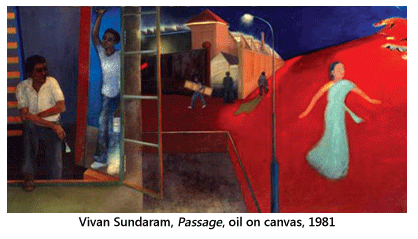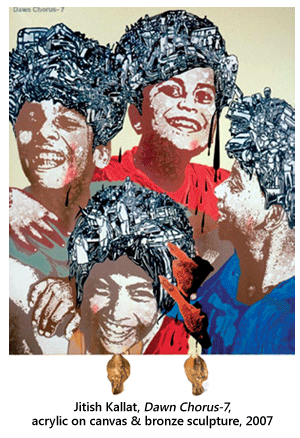- Prelude
- Editorial
- A Conversation with Sheela Gowda
- The DIY Artist with a Mission
- Discovering Novel Horizons
- A Conversation with Raqs Media Collective
- Manjunath Kamath
- Jitish Kallat- the Alchemist
- The Artist and the Dangers of the Everyday: Medium, Perception and Meaning in Shilpa Gupta's work
- An Attitude for the Indian New Media
- Weave a Dream-Theme Over Air or a Medium like Ether
- Installation in Perspective: Two Outdoor Projects
- Towards The Future: New Media Practice at Kala Bhavana
- Workshop @ Facebook
- Desire Machine: Creating Their Own Moments…
- Typography: The Art of Playing with Words
- Legend of a Maverick
- Dunhill-Namiki
- The Period of Transition: William and Mary Style
- The Beauty of Stone
- Nero's Guests: Voicing Protest Against Peasant's Suicides
- Patrons and Artists
- The Dragon Masters
- What Happened and What's Forthcoming
- Art Chennai
- Art Events Kolkata
- Winds of Change
- Art Bengaluru
- Mumbai Art Sighting
- Musings from Chennai
- In the News
- Previews
- Ascending Energy, Merging Forms: Works by Satish Gujral
- Re-visiting the Root
- The Presence of Past a New Media Workshop
- Taue Project
ART news & views
Patrons and Artists
Volume: 3 Issue No: 15 Month: 4 Year: 2011
Market Monitor
by Art Bug
There is an inherent irony in the progress of new media art in India. As Nancy Adajania, the Mumbai-based curator and critic had written in her article in Art and the City, a Goethe Institute publication, “In a strange way, the new popularity of these art forms will bury them in plain sight. Why do I make this paradoxical statement? While galleries today no longer reject 'new media art', and even include such practices as an extension of patronage, not enough discourse is generated around such questions as the demographics of reception, the politics and ethics of producing such art and the curation of dematerialised art."
And that is where the irony lies. Public perception of the 'spirit' of new-media art, especially in the subcontinent is to an extent 'confused'. This also includes artists. In fact, there is a 'great divide' between the two schools of thought in India. While practitioners of the old school the two-dimensional canvas art or the three dimensional sculptural art still insist that these are the mainstay in market contexuality, new media practitioners argue that the market for their kind of art is increasingly growing bigger. So what is the real picture?
Artist Manjunath Kamath, speaking to Ashok Nag of the Economic Times, in 2009 had said, “Although I don't make any distinction between different forms of art, I have been creating a lot of digital prints, video art and installations recently. Initially, when I did digital prints, it was experimental art and I did not expect a market for that. Five years back when I had done a digital print and video show, not a single print was sold. Lately, I staged a show at the Indian Art Summit, I created a huge digital print, measuring 6 by 9 feet, and all three editions sold out. While the first edition went for Rupees 8 lakh, the second was picked up at Rupees 9 lakh and the third was acquired for Rupees 12 lakh." Kamath and other practitioners have,  way back in 2009 started handing out "authentication certificates" along with their creations in an effort to gain the trust of collectors.
way back in 2009 started handing out "authentication certificates" along with their creations in an effort to gain the trust of collectors.
Between 2009 and 2011, the picture has definitely changed. Artprice.com now lists artists like Jitish Kallat among its top 10 Indian artists confidence indicator list. Naturally, since Kallat's works have started drawing attention on an international level. He has commanded anything between $154,440 and $320,000 in the international market. What is noteworthy here is that his highest prices were reached at International auction houses during the recession years. Dawn Chorus-7, a 2007 creation of mixed media on canvas and two bronze sculptures, sold at Christie's New York for $320.000 in September 2009. Last year, in November, his Untitled (Eclipse), a 2008 creation of acrylic on canvas (tryptich), sold at Christie's Hong Kong, for $296, 469.
Compare this with another Indian stalwart's top performance in the world market. Vivan Sundaram's hammer prices have ranged between $42,500 and $ 5,890. He had achieved this price way back in 2006, when the market for Indian art was still looking at art in the traditional mould. His Passage 1981, which is till now his highest priced work of art, was an oil on canvas creation, while his new media practice a Photo Montage titled Father-Daughter/Studio: 30's deco, a 2001 creation, went for a hammer price of $ 5,890, at Christie's London in 2008.
In this context, Sundaram's words are noteworthy. “It is human nature to reject the unfamiliar. We are generically conservative. Art produces new generation and the new generation produces art. Impressionists' paintings were not accepted initially and questioned by salon realistic art. Same way in the 1990s when installation art had begun to make a ground, senior artists of the country commented that it is West influenced art, etc,” he said in an interview to ArtConcerns.com. While focussing on the 'great divide' referred to earlier in this article, Sundaram also added that, “Now, the 'direct-consumption' has under went change, i.e. the circulation of art as a commodity and its relationship with money has changed. The work of art need not have immediate 'sale-value'. The market is becoming more inclusive. Radical collectors like Anupam Poddar are buying what is outside auction scene, outside the benchmark.”
It is therefore of critical importance that new-media art has the right kind of patronisation. In India, as of now, that patronisation is slowly increasing. Adajania, in her article notes, “Indian experiments in this field need to be seen as local improvisations and not as custom-made variants on a universal new media practice. The work of these artists is sustained by a renewed quest for autonomy in a historical period characterised by heavily increased yet largely imperceptible controls on individual choice and movement; restrictions on access and passage; surveillance; militarisation; as well as the constrictions of an often violent identity politics based on religion, ethnicity, and regional affiliation. Many of these artists seek to locate their being and their practice in alternative sites that are neither state nor market, neither gallery nor political party.”
This is exactly where the collector plays a critical role is raising the bar. Without the right kind of support, it is almost impossible for these alternative practitioners to survive in a market that still regards art in the traditional 'static' format. True, auction houses are slowly opening up to the possibilities of new media. Video art, prints etc are now increasingly appearing at auctions conducted by the duopoly and others. To quote Maithili Parekh, Sotheby's deputy director when she spoke to ET in 2009, "Sotheby's has offered installations, video art, and performative photography in auctions over the years. Examples include Sonia Khurana's Bird, made in 2006-2007 which is considered one of the most iconic pieces of video art and still image in Indian contemporary art. Exhibited the world over, including the House of World Cultures in Berlin, Arario Gallery in Beijing, and the Pompidou Centre in Paris, the work sold for $46,000 on hammer. A single channel video piece by Hetain Patel and Surekha's photo-installation The Fragrance of Jasmine have also been in auction. Surekha's work, which consisted of eighty three framed photographs sold for $22,000 in September 2007 in New York."

But a cursory look at the price such pieces commandedbe it Kallat's, Sundaram's, Raqs Media's, Khurana's, Surekha's or Patel's, will make it clear that new media art is more about enthusiasm than about the market. Adajania is of the opinion that the support from traditional quarters has been 'incipient' and thus to an extent, it has also influenced collectors and observers, who have been characterised by a 'cautious receptiveness'. And that is why institutions like the Devi Art Foundation are important. “The Devi Art Foundation marks an exception to the rule. Established by Lekha and Anupam Poddar, it is the first private museum for contemporary art in India. Anupam Poddar has consistently nurtured cutting-edge art forms, even at a time when no market context existed for them,” she added.
As is evident, Anupam Poddar is mentioned by both a critic and curator like Adajania and an artist like Sundaram. The reason is simple. He has been the first patron of the new form of contemporary Indian art that is grouped as 'newmedia'. Sundaram also adds, “Installation-art is related to space and architecture, and cannot be presented directly as a concept of consumption like a painting. It works in a public domain. It is not bought by the private collector unless the collector has a space to exhibit. Aspects of installations are public in nature, and Museums should be accepting it as an art-object. Site-specific involves sponsorship. My Memorial (he was referring to the installation he did at Kolkata's Victoria Memorial) was bought by a private collector. Apart from conceptual frame, installations require some financial backing.”
In the final analysis therefore, the market contexuality of 'new media art' from India has still a lot to achieve. And like every form of art that has been able to achieve a market contexuality, it is in desperate need of patronisation, be it state-sponsored or private. Outside India, the state plays a very important role in supplementing the fund for the development of this genre. In India however, the situation is absolutely different and artists have to depend on a handful of private fund-givers to sustain their efforts. And as far as the traditional market contexuality is concerned, no matter what Christies or Sotheby's claim, new media art is still at the fringes, if it is not by someone like Andy Warhol.
Image Courtesy: Christie's